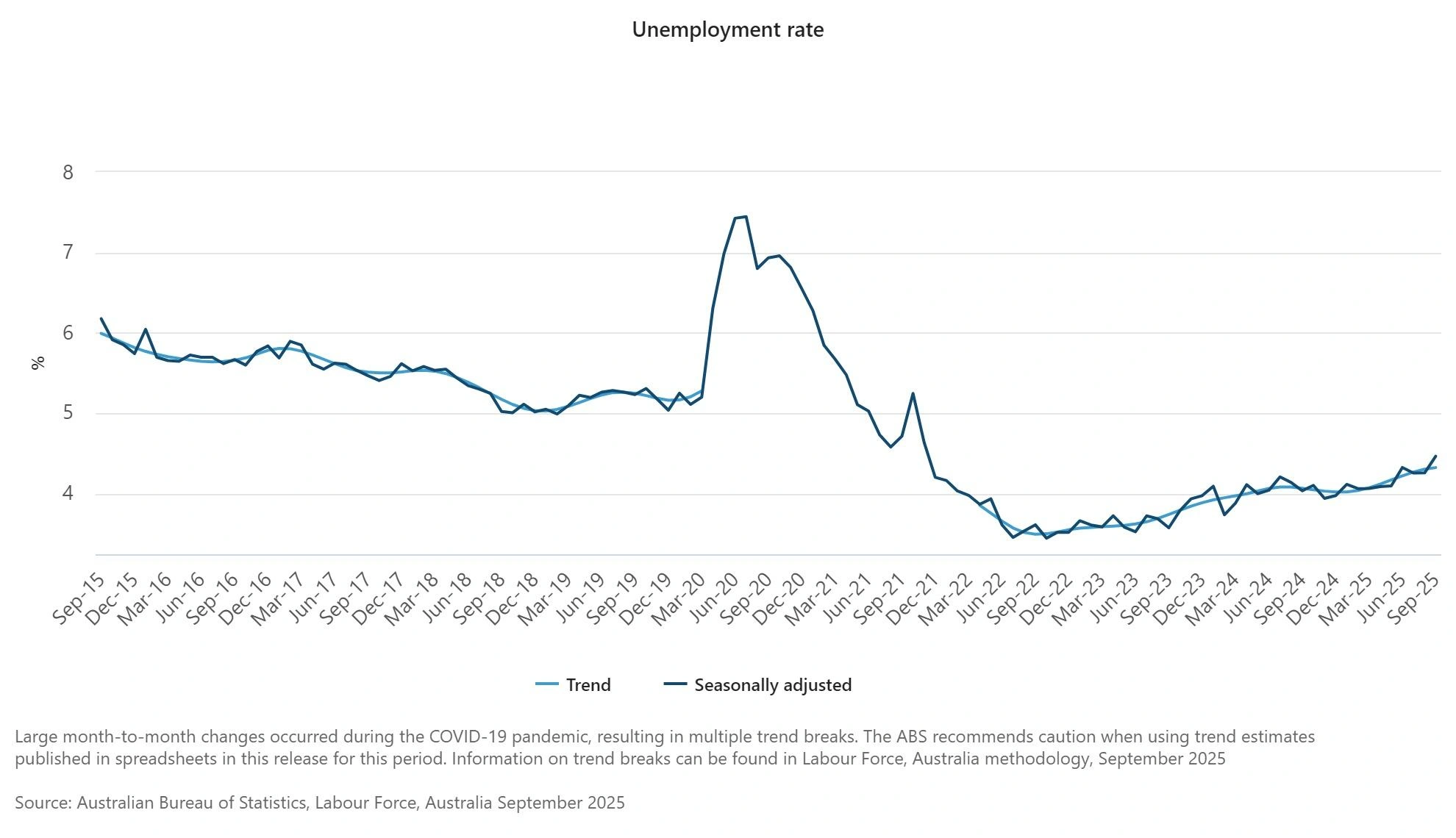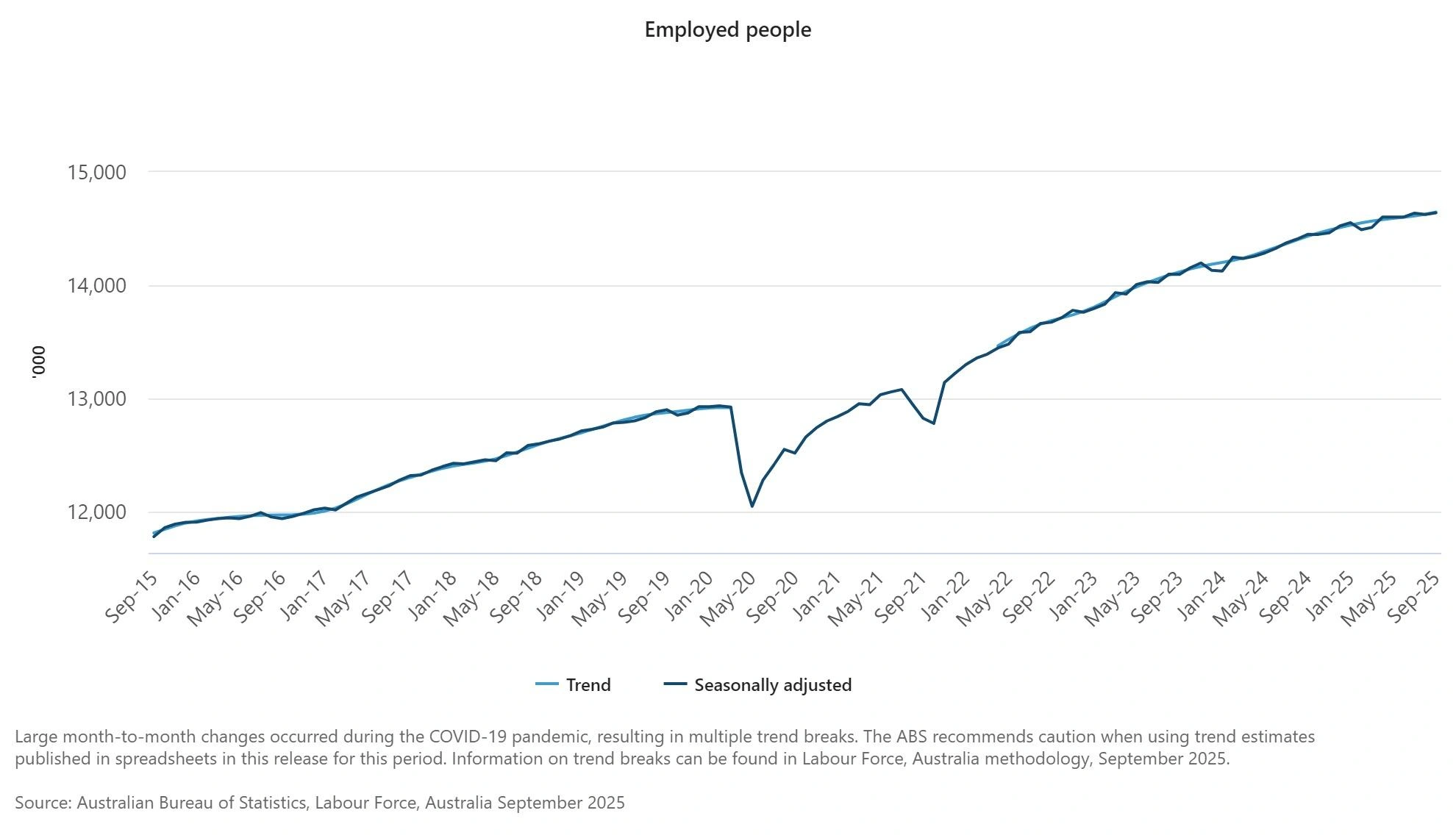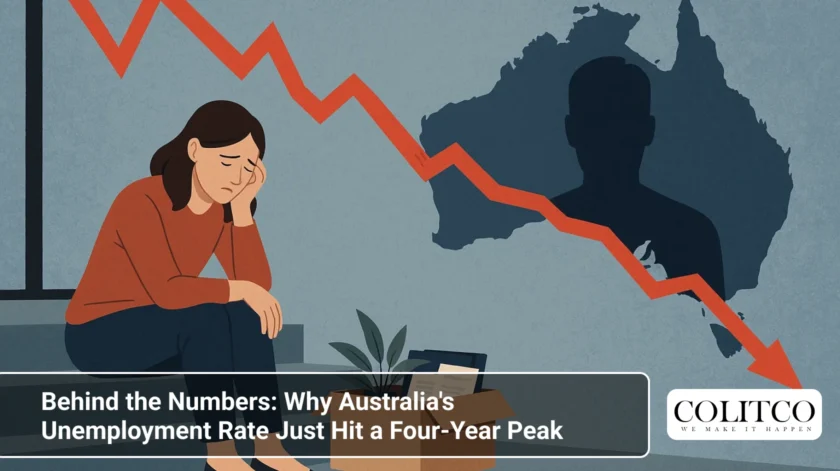Australia’s labour market delivered an unwelcome surprise in October. The unemployment rate surged to 4.5% in September, marking the highest level since November 2021.
The jump came despite 14,900 new jobs being created, falling short of the 20,000 economists had forecast.
More significantly, 34,000 additional Australians joined the ranks of the unemployed. This development has reignited speculation about potential interest rate cuts from the Reserve Bank of Australia (RBA) as soon as next month.
The Participation Rate Story
The Australian Bureau of Statistics (ABS) revealed a key factor driving the unemployment spike. The participation rate climbed to 67.0% in September, up from 66.8% in August.
Sean Crick, ABS head of labour statistics, explained the dynamic at play.
“There were 34,000 more unemployed people in September. The number of employed people also grew, up 15,000 in the same period,” he stated.
This simultaneous increase in both employment and unemployment reflects more Australians actively seeking work. While employment increased to 14,640,200, the flood of new job seekers outpaced available positions.
The participation rate, though elevated, remains below the record high of 67.2% recorded earlier this year.
 Australia Unemployment Rate
Australia Unemployment Rate
Market Reaction: Rate Cut Expectations Surge
Financial markets responded swiftly to the data. The Australian dollar slipped 0.4% to $0.6488, while three-year government bond yields declined.
Most significantly, traders dramatically repriced their expectations for the RBA’s November meeting.
Market pricing now suggests a 71% probability of a 25 basis point rate cut. This represents a sharp increase from just 40% before the employment report’s release.
The ASX 200 reached a record high following the announcement, with investors anticipating relief from the central bank’s monetary tightening cycle.
Commonwealth Bank economists have maintained their forecast for a November rate cut, which would take the cash rate to 3.35% by year-end.
Linking this to broader economic trends, Australia’s inflation has been trending downward, strengthening the case for monetary policy easing.
Full-Time vs Part-Time Employment Breakdown
The September labour market data revealed nuanced shifts in employment composition.
Full-time employment increased by 8,700 positions to reach 10,082,800 people. Part-time employment rose by 6,300 to 4,557,400 workers.
This represents a more balanced growth pattern compared to recent months, where part-time employment surges had dominated.
The employment-to-population ratio remained steady at 64.0%, suggesting the labour market’s overall absorption capacity hasn’t significantly changed.
Underemployment Concerns Mount
Beyond headline unemployment, underemployment also deteriorated in September.
The underemployment rate increased by 0.2 percentage points to 5.9% in seasonally adjusted terms. This measures workers who want more hours but can’t find them.
The combined underutilisation rate, encompassing both unemployment and underemployment, jumped by 0.4 percentage points to 10.4%.
This broader measure of labour market slack provides a more comprehensive picture of unused capacity in the workforce.
“The rise in both unemployment and underemployment signals growing softness in the labour market,” noted MacroBusiness in their analysis.
What’s Driving More People into the Job Market?
Several structural factors explain the elevated participation rate.
First, expanded childcare subsidies have enabled more parents, particularly mothers, to return to work. The 2025 budget introduced capped out-of-pocket costs, reducing barriers to workforce participation.
Second, flexible work arrangements established during the pandemic have persisted. Remote and hybrid work models continue attracting individuals who previously faced barriers to traditional employment.
Third, cost-of-living pressures have forced more households into dual-income arrangements. With mortgage stress elevated and consumer prices still rising, families need two incomes to maintain living standards.
Fourth, superannuation rule changes have incentivised older Australians to remain in or return to the workforce part-time.
 Employment increased by 19,900 people (0.1%) to 14,647,000 people
Employment increased by 19,900 people (0.1%) to 14,647,000 people
Historical Context Matters
September’s 4.5% unemployment rate represents the highest level in nearly four years. However, historical perspective reveals this remains relatively low.
Australia’s unemployment averaged 6.55% from 1978 to 2025. The rate peaked at 12.13% in February 1993 during a severe recession.
The record low of 3.25% was achieved in November 2022, during the post-pandemic labour market boom.
Current levels suggest Australia’s labour market remains relatively healthy by historical standards, despite recent deterioration.
RBA’s Forecasting Challenge
The RBA’s most recent Statement on Monetary Policy forecast unemployment would peak at just 4.3% and remain there until late 2027.
September’s 4.5% reading already exceeds this forecast, raising questions about the central bank’s economic modelling.
Governor Michele Bullock has emphasised the RBA’s data-dependent approach to monetary policy. The unexpected unemployment spike provides compelling evidence that labour market conditions have loosened more than anticipated.
AMP Capital’s Oliver’s Insights suggests the cash rate could fall to 2.85% by mid-2026 if labour market softness persists.
Regional and Demographic Variations
While national figures provide the headline story, significant regional differences exist.
Victoria’s unemployment rate stood at 4.59% in March 2025, lower than September’s national average. Tasmania and South Australia typically experience higher unemployment than New South Wales and Queensland.
Youth unemployment, consistently higher than the overall rate, remained around 9.0% earlier in the year. Young workers continue facing disproportionate challenges entering the labour market.
Female workforce participation reached record highs earlier in 2025, at 63.5%, though this has moderated slightly since.
What Happens Next?
The RBA Board meets on November 3-4 to decide monetary policy. September’s labour market weakness strengthens the case for resuming rate cuts.
However, the central bank won’t respond to a single data point. August employment figures were also weak, showing a 40,900 decline in full-time positions.
Two consecutive months of disappointing results create a pattern the RBA cannot ignore.
October’s inflation data, due before the November meeting, will provide crucial context. If price pressures continue moderating while unemployment rises, the case for easing becomes compelling.
NAB economists expect the cash rate to reach 3.10% by February 2026. Westpac forecasts 2.85% by mid-2026.
These projections assume continued labour market softening and inflation remaining within the 2-3% target band.
Broader Economic Implications
Rising unemployment carries significant economic consequences beyond monetary policy.
Consumer spending typically weakens when job security deteriorates. Households become more cautious, reducing discretionary purchases and increasing savings.
This creates a feedback loop. Weaker consumption slows economic growth, potentially forcing businesses to reduce hiring or cut jobs.
The federal government faces budget pressures from higher JobSeeker payments and lower income tax revenue if unemployment continues rising.
Business confidence may also soften as labour market slack increases, potentially deferring investment decisions.
Also Read: BHP’s Australia Boss Breaks Silence on Trade Storm: What It Means for Iron Ore Markets
Frequently Asked Questions
Q: Why did Australia’s unemployment rate increase if employment grew?
A: The unemployment rate rose because the number of people entering the job market (34,000) exceeded the number of new jobs created (14,900). A higher participation rate means more Australians are actively seeking work, and not all of them found employment.
Q: Will the RBA cut interest rates in November?
A: Market pricing suggests a 71% probability of a 25 basis point rate cut at the November 3-4 meeting. The weaker-than-expected employment data strengthens the case for easing, though the RBA will also consider upcoming inflation figures before deciding.
Q: Is 4.5% unemployment considered high in Australia?
A: By historical standards, 4.5% remains relatively low. Australia’s unemployment averaged 6.55% from 1978 to 2025. However, it represents the highest level since November 2021 and exceeds the RBA’s forecasts, signalling a significant deterioration in labour market conditions.
Q: What sectors are most affected by rising unemployment?
A: While comprehensive sector-specific data for September hasn’t been released, retail, hospitality, and construction typically experience greater volatility during economic slowdowns. Professional services and healthcare have shown more resilience in recent months.
Q: How does Australia’s participation rate compare internationally?
A: Australia’s 67.0% participation rate ranks among the highest in the OECD. Strong childcare support, flexible work arrangements, and demographic factors have driven high workforce engagement compared to many developed economies.












